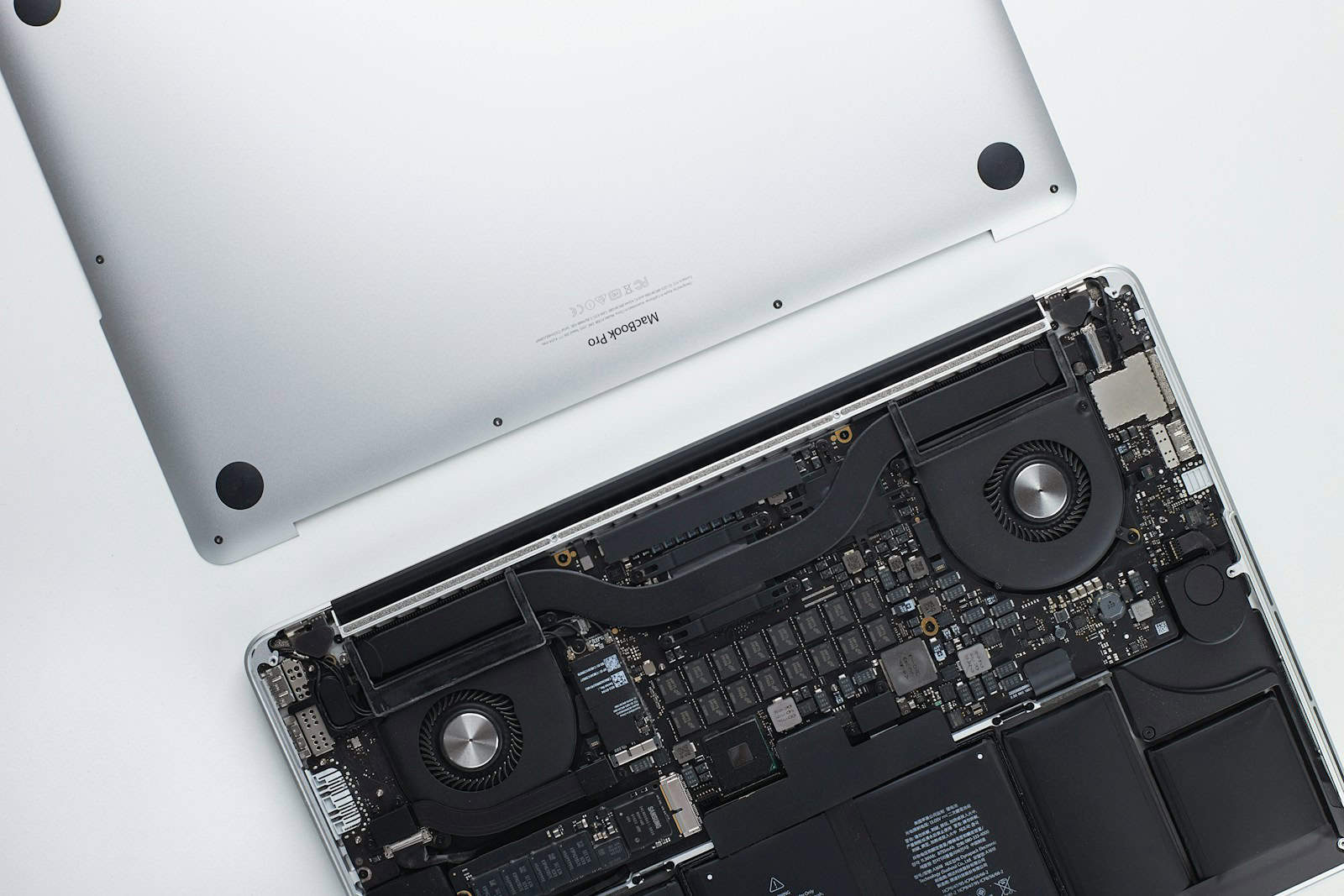Is your laptop constantly dying or shutting down without warning? These problems are often signs of a failing battery. Many laptop owners don’t realize their battery is the culprit until it’s completely dead.
Your laptop battery needs replacement when it holds less than 40-80% of its original capacity, shuts down unexpectedly, or takes longer than normal to charge. Mac users should consider replacement when battery health drops below 80%, while Windows laptop users might wait until it falls below 40%. This difference reflects how various manufacturers measure battery health.
You might also notice your laptop overheating or battery bulging as it ages. These symptoms not only affect performance but can potentially damage other components in your device. Checking your battery health regularly through built-in diagnostic tools can help you decide when it’s time for a replacement.
Signs Your Laptop Needs a New Battery
Laptop batteries degrade over time, and recognizing when yours needs replacement can save you from unexpected shutdowns and data loss. Here’s a guide to help you identify the signs that your laptop battery is failing and when it’s time to get a new one.
Common Signs Your Laptop Battery Needs Replacement
1. Rapid Battery Drain
If your laptop battery percentage drops quickly even after a full charge, it’s a clear sign the battery’s capacity has diminished.
2. Battery Won’t Hold a Charge
When your laptop dies shortly after unplugging the charger or won’t charge beyond a certain percentage, the battery may be worn out.
3. Unexpected Shutdowns
Your laptop suddenly powers off despite showing remaining battery life. This indicates inaccurate battery reporting or battery failure.
4. Overheating Battery
Excessive heat while charging or using the laptop can signal battery problems and potential safety hazards.
5. Battery Swelling
Physical swelling or bulging of the battery or laptop chassis is a serious issue and requires immediate battery replacement.
6. Slow Charging or Not Charging
If your battery takes much longer to charge or doesn’t charge at all, it may be failing.
7. Battery Age
Most laptop batteries last between 2-4 years or 300-500 full charge cycles. If your battery is older, it’s wise to monitor its health closely.
How to Check Battery Health
- Windows:
Runpowercfg /batteryreportin Command Prompt to generate a detailed battery report.
Or use the Battery Health feature in Windows Settings. - Mac:
Hold the Option key and click the battery icon in the menu bar to see battery condition.
Or check System Information > Power for cycle count and condition. - Third-Party Apps:
Tools like BatteryInfoView (Windows) or coconutBattery (Mac) provide detailed battery health stats.
What to Do When Your Battery Shows These Signs
- Replace the Battery:
Purchase an original or certified replacement battery compatible with your laptop model. - Optimize Battery Usage:
Adjust power settings, reduce screen brightness, and close unnecessary apps to extend battery life temporarily. - Seek Professional Help:
If your battery is swelling or overheating, stop using the laptop and consult a technician immediately.
Summary Table: Signs and Actions
| Sign | Description | Recommended Action |
|---|---|---|
| Rapid Battery Drain | Battery loses charge quickly | Monitor usage; consider replacement |
| Won’t Hold Charge | Laptop dies soon after unplugging | Replace battery |
| Unexpected Shutdowns | Sudden power-offs despite battery indicator | Replace battery |
| Overheating Battery | Excess heat during use or charging | Stop use; seek professional help |
| Battery Swelling | Physical bulging of battery or chassis | Immediate replacement required |
| Slow or No Charging | Charging takes very long or doesn’t happen | Replace battery |
| Old Battery Age | Battery older than 2-4 years or many cycles | Plan for replacement |
Recognizing these signs early and replacing your laptop battery when needed will ensure your device runs smoothly and safely.
Key Takeaways
- A significant decrease in battery life or sudden shutdowns are clear indicators your laptop battery needs replacement.
- Different computer brands have varying thresholds for battery replacement – 80% for Macs and 40% for many Windows laptops.
- Regular battery health checks using your device’s built-in diagnostic tools can prevent unexpected failures and extend your laptop’s lifespan.
Recognizing Signs of Battery Degradation
Laptop batteries naturally wear down over time, affecting your computer’s performance. Knowing when your battery is failing can save you from unexpected shutdowns and productivity losses.
Sudden Power Offs and Irregular Charge Levels
One of the most frustrating signs of battery degradation is when your laptop shuts down without warning. This often happens even when your battery indicator shows a decent charge level, like 30% or 40%.
Your laptop might report incorrect battery percentages. You might see it jump from 50% to 15% in minutes, or stay at 100% for hours and then suddenly drop. These inconsistent readings happen because the battery’s internal chemistry is breaking down.
Windows users can check battery health by generating a battery report. Open Command Prompt as administrator and type: powercfg /batteryreport. This creates a report showing your current capacity versus the original design capacity.
For Mac users, hold the Option key and click the Apple menu, then select “System Information” and check “Power” to see your battery condition.
Extended Charging Times and Reduced Usage Duration
A healthy laptop battery charges in 1-2 hours. If yours now takes 3+ hours to reach full charge, that’s a clear warning sign.
Battery life shrinks significantly as batteries age. If your once 4-hour battery now lasts only 1-2 hours on a full charge, degradation is occurring. This happens because the battery’s full charge capacity decreases over time.
You can track this decline: most laptops initially offer 300-500 charge cycles before capacity drops below 80% of original. After this point, performance declines more rapidly. Many manufacturers recommend battery replacement when capacity falls below 80% of the original design capacity.
Physical Battery Swelling
Battery swelling is a serious problem that demands immediate attention. A swollen battery might cause your laptop’s case to bulge, trackpad to rise, or keyboard to feel uneven.
This happens when gases build up inside the battery due to chemical reactions. It indicates serious battery damage and poses safety risks including potential fire hazards.
Never use a laptop with a swollen battery. Power it down, unplug it, and get the battery replaced right away. Continuing to use a swollen battery can damage other components and poses serious safety risks.
Modern laptops often have built-in battery management systems that can alert you to battery issues before physical swelling occurs. Pay attention to any system warnings about battery health.
Understanding Battery Life and Health Metrics
Knowing how to measure your laptop battery’s health lets you make smart decisions about when to replace it. Several key metrics can tell you if your battery is still working well or if it’s time for a new one.
Battery Capacity History Analysis
Battery capacity history shows how your battery has performed over time. Most laptops track this information in the system settings or through special software. On Windows, you can access a battery report by opening Command Prompt and typing “powercfg /batteryreport” which saves a detailed HTML file.
For Mac users, hold the Option key and click the Apple menu, then select “System Information” and find “Power” to see battery cycle count and condition.
These reports show how many charge cycles your battery has gone through. Most laptop batteries last between 300-500 cycles before significant degradation occurs.
Checking this history regularly helps you spot declining trends before they become serious problems.
Design vs. Full Charge Capacity
Design capacity refers to how much power your battery could hold when it was new. This is measured in milliampere-hours (mAh) or watt-hours (Wh).
Full charge capacity shows how much power your battery can hold now. As batteries age, this number decreases.
For example, a battery with a design capacity of 5000 mAh might now only reach 4000 mAh when fully charged. This 20% reduction affects how long your laptop runs between charges.
A healthy battery generally maintains at least 80% of its original capacity. When your full charge capacity drops below 60% of the design capacity, experts recommend replacement.
Interpreting the Battery Health Status
Battery health status is often displayed as a percentage or condition rating. Here’s what different levels typically mean:
90-100%: Excellent condition – your battery works like new
80-89%: Good condition – slight decrease in runtime but still reliable
60-79%: Fair condition – noticeable shorter runtime, consider replacement soon
Below 60%: Poor condition – battery needs replacement
Other warning signs include:
- Battery draining from 100% to 0% in under an hour of normal use
- Laptop shutting down unexpectedly even with battery percentage remaining
- Battery taking much longer to charge than when new
- Physical signs like swelling or overheating
Modern laptops often include built-in diagnostics that can tell you when your battery needs replacing. Check your manufacturer’s support tools for specific guidance.
Utilizing Built-in Battery Diagnostic Tools
Most laptops come with built-in tools to check battery health. These diagnostic tools can help you understand your battery’s current condition and decide if replacement is necessary.
Running the Powercfg /batteryreport Command
Windows has a powerful built-in tool that creates detailed battery reports. To access it, open Command Prompt by typing “cmd” in the search bar. Right-click and select “Run as administrator” for full access to the system.
Once Command Prompt opens, type powercfg /batteryreport and press Enter. This command generates a comprehensive battery health report. The system will display a message showing where the report is saved, typically in the C:\Users[YourUsername] folder.
The report is created as an HTML file, making it easy to open and read. You can navigate to the file location through File Explorer or click on the path directly from Command Prompt to open it.
Analyzing the Battery report.html File
The battery report contains valuable information about your laptop’s power system. Open the batteryreport.html file in any web browser to view the report.
Look for the “Battery Capacity History” section. This shows your battery’s design capacity versus its current full charge capacity. If current capacity is below 80% of the original design capacity, your battery may need replacement.
Pay attention to the “Battery Life Estimates” section as well. This compares your battery’s estimated life when new to its current performance. A significant decrease suggests battery deterioration.
The report also includes “Usage History” that shows how your battery drains over time. Sudden drops in percentage or unusually fast drainage indicate potential battery issues that might require replacement.
Evaluating When To Replace Your Laptop Battery
Knowing the right time to replace your laptop battery can save you from unexpected shutdowns and help you avoid overspending on premature replacements. Battery replacement decisions should balance performance needs against cost considerations.
Comparing Warranty and Battery Lifespan
Most laptop batteries come with a warranty period of 6-12 months, while the laptop itself typically has a 1-3 year warranty. Check your warranty details before purchasing a new battery, as some manufacturers cover battery replacements during this period.
Battery lifespan generally ranges from 2-4 years depending on usage patterns and care. Replacing a battery that still holds 80% or more of its original capacity might be premature unless you require maximum runtime.
For Windows laptops, many experts suggest replacement when capacity drops below 40%, while Mac users often replace batteries at the 80% health threshold. These differences reflect varying battery management systems between platforms.
When to act regardless of warranty:
- Battery swelling (safety hazard)
- Complete failure to hold charge
- Runtime reduced to less than 30 minutes
Measuring Battery Performance Against Usage Needs
Your specific usage requirements should guide replacement decisions. A laptop that stays plugged in most of the time might function acceptably even with reduced battery capacity.
To evaluate if your current battery meets your needs, track how long it lasts during typical work sessions. If you frequently find yourself searching for outlets or experiencing anxiety about battery levels, replacement likely makes sense.
Use built-in battery health reporting tools:
- Windows: Generate a battery report using Command Prompt with
powercfg /batteryreport - Mac: Check Battery Health in System Settings
- Third-party apps: Programs like BatteryBar or coconutBattery provide detailed metrics
Compare the current maximum capacity against the original design capacity. A battery operating at less than 50% of original capacity that no longer supports your work style is a prime candidate for replacement.
System Settings Affecting Battery Performance
Your laptop’s battery life depends heavily on how your system settings are configured. By adjusting power options and monitoring battery usage, you can significantly extend how long your laptop runs between charges.
Adjusting Windows 10 Power Options
Windows 10 offers several ways to customize power settings for better battery life. To access these options, click the battery icon in the taskbar and select “Power & sleep settings.” From there, click “Additional power settings” to open Power Options.
The most important settings include:
- Power plan selection: Choose “Balanced” for everyday use or “Power saver” when battery life is critical
- Screen brightness: Lower brightness can save 30-40% battery power
- Sleep timers: Set your display to turn off after 5 minutes of inactivity
- Background apps: Disable unnecessary apps running in the background
You can create a custom power plan by clicking “Create a power plan” and adjusting advanced settings like processor power management and display timeout.
Reviewing Electricity Consumption and Battery Settings
Monitoring your laptop’s energy usage helps identify power-hungry applications and hardware. Windows 10 provides built-in tools to track battery consumption.
Open Settings and go to “System” > “Battery” to view a breakdown of which apps use the most power. This shows consumption in watt hours (Wh), helping you identify battery-draining culprits.
Key settings to check include:
- Battery saver threshold: Set when battery saver activates (typically 20%)
- Background app limitations: Restrict apps from running in background
- Battery usage per app: Review which programs consume the most power
The “Battery usage by app” section ranks applications by power consumption. Consider uninstalling or limiting apps that consistently appear at the top of this list.
Frequently Asked Questions
Laptop battery issues show themselves through several key warning signs. These indicators can help you decide when replacement is necessary and how to maintain your current battery for longer life.
How can I tell if my laptop battery needs replacing?
Watch for shortened battery life as the main sign. If your laptop used to run for hours but now dies after 30 minutes, it’s time for a new battery.
Unexpected shutdowns even when the battery indicator shows charge remaining suggests the battery is failing. This happens when the battery can’t hold its charge properly anymore.
Slow charging is another clear indicator. When your laptop takes much longer than usual to reach full charge, the battery likely needs replacing.
What physical symptoms indicate a dying laptop battery?
Overheating is a common physical sign of battery problems. If your laptop feels unusually hot, especially near the battery area, this could indicate battery failure.
A swollen or bulging battery case is a serious warning sign. This physical deformation means the battery is damaged and potentially dangerous. Replace it immediately.
Strange noises or a laptop that won’t sit flat on a surface might also indicate a swollen battery pushing against the laptop’s case.
Is it cost-effective to replace a laptop battery or should I consider purchasing a new laptop?
Battery replacement is usually more cost-effective for newer laptops. A new battery typically costs $30-$100, while a new laptop starts at several hundred dollars.
For laptops over 5 years old, consider the overall condition. If other components are also showing age or if the laptop is already slow, a full replacement might make more sense.
Check if your laptop model has an easily replaceable battery. Some modern laptops have batteries glued or built into the case, making replacement more expensive.
What steps can I take to check the health of my laptop battery?
Use built-in battery health tools on your operating system. Windows has a battery report feature you can access through the command prompt with “powercfg /batteryreport”.
Check the battery health percentage. Generally, a battery at 80% health or higher is still good, while anything below 60% should be replaced soon.
Third-party battery monitoring apps can provide more detailed information about cycles, wear level, and estimated remaining lifespan.
What are the best practices for maintaining laptop battery health to avoid premature replacement?
Avoid extreme temperatures as heat damages batteries. Don’t leave your laptop in hot cars or use it on soft surfaces that block cooling vents.
Maintain partial charges instead of full cycles. Keeping your battery between 20% and 80% charged is better than constantly draining it completely.
Use power-saving settings and reduce screen brightness to decrease battery strain. Close unused applications and disable background processes that drain power unnecessarily.
How does operating system like Windows 10 or Windows 11 signal that laptop battery is failing?
Windows displays a red “X” over the battery icon when it detects serious battery issues. Click this icon to see specific warnings about battery replacement.
Battery notifications in the Action Center will appear when Windows detects poor battery health. These messages specifically suggest considering battery replacement.
The power troubleshooter in Windows can identify battery problems. Access this by searching “troubleshoot power” in the Windows search bar and following the prompts.






